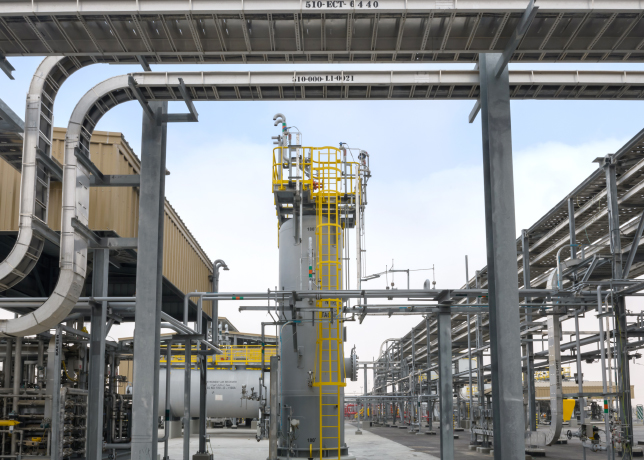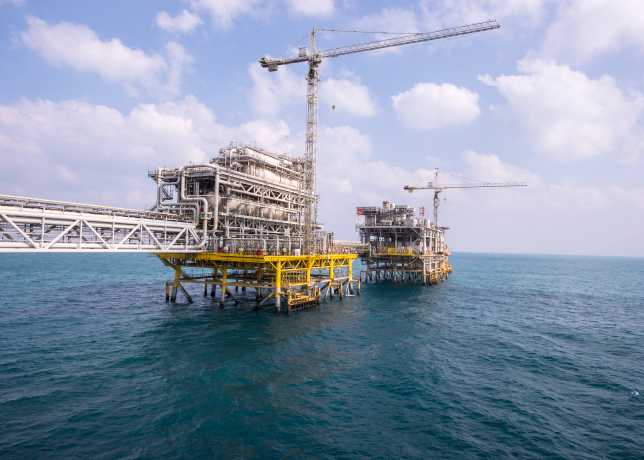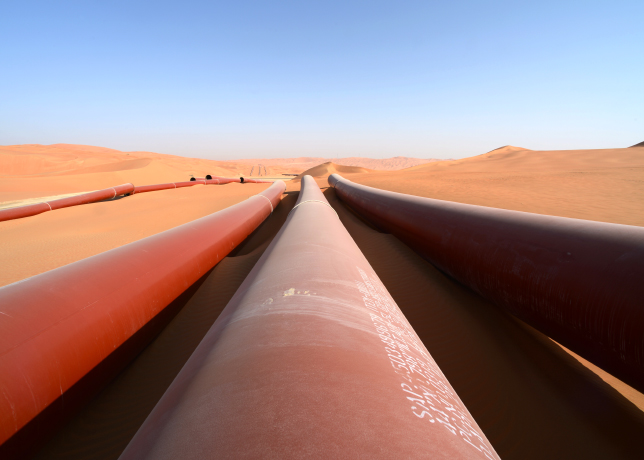
 Aramco operates vast offshore oil fields in the Arabian Gulf
Aramco operates vast offshore oil fields in the Arabian Gulf
The oil giant posted resilient results in H1 2025, and is expanding upstream and downstream portfolios, accelerating renewables and technology ventures, and is deepening global investments while reinforcing integration strategies across oil, gas, chemicals, and new energies
Saudi Aramco, one of the world’s largest integrated energy and chemicals companies, entered 2025 with strong momentum, posting robust financial results and advancing a broad portfolio of upstream, downstream, and renewable projects.
From record dividend payouts to expanding its global refining and retail presence, the company has reinforced its dual identity as a hydrocarbon powerhouse and an emerging force in lower-carbon energy.
Against a backdrop of market volatility and geopolitical uncertainty, Aramco continues to deliver stability in global energy supply while steadily broadening its horizons in gas, renewables, and digital innovation.
In its Q2 and H1 2025 results, Aramco reported adjusted net income of $24.5 billion for Q2 and $50.9 billion for H1, underlining the company’s resilience despite softer oil prices.
Cash flow from operating activities reached $59.3 billion in H1, with free cash flow at $34.4 billion. The gearing ratio rose modestly to 6.5 per cent by June 2025, reflecting higher borrowings linked to major projects and bond issuances.
Dividends remain central to Aramco’s investor appeal. For Q2 2025, the board declared a base dividend of $21.1 billion, supplemented by a performance-linked dividend of $0.2 billion.
Across H1 2025, total dividend distributions amounted to $42.7 billion, reinforcing the company’s policy of sharing upside value while shielding investors through down cycles.
Since its IPO in 2019, Aramco has paid out nearly $442 billion in dividends, an unmatched figure in the energy sector.
Capital markets continue to back Aramco’s long-term growth strategy. In June 2025, the company raised $5 billion in a three-tranche bond issuance listed on the London Stock Exchange.
Earlier in 2024, it completed a $6 billion international bond and a $3 billion sukuk, both heavily oversubscribed, reflecting global investor confidence.
The bond and sukuk issuances are part of Aramco’s broader effort to diversify its investor base and provide international markets with regular access to its debt programme.
These instruments have extended maturities as far as 30 years, offering long-term investors exposure to a company widely regarded as one of the most financially resilient in the energy sector.
 |
Amin Nasser |
In 2024, the Saudi government also completed a secondary public offering of approximately 0.7 per cent of the company’s issued shares, improving liquidity and diversifying ownership.
This broadening of investor participation underscores the strength of Aramco’s balance sheet and its unique competitive advantages, including low lifting costs averaging around $3.5 per barrel of oil equivalent, one of the world’s lowest upstream carbon intensities at 9.7 kg of CO2 per barrel of oil equivalent (boe), and unmatched reserves of 250 billion boe.
Together, these factors continue to underpin its ability to generate strong cash flows, support record dividends, and fund one of the largest capital expenditure programmes in the industry — over $50 billion annually.
INVESTMENTS & PORTFOLIO SHIFTS
Aramco has been steadily optimising its portfolio. In early 2025, it acquired additional equity in Petro Rabigh by converting shareholder loans into equity, raising its stake towards majority ownership.
SABIC, its 70 per cent-owned chemicals subsidiary, advanced portfolio streamlining by completing the $960 million sale of its stake in Aluminium Bahrain (ALBA) and finalising the transfer of Hadeed steel to the Public Investment Fund (PIF).
On the expansion front, Aramco deepened its global retail strategy with acquisitions in Chile (Esmax) and Pakistan (40 per cent of Gas and Oil Pakistan).
Both investments represent Aramco’s first retail footholds in South America and South Asia respectively.
The company also expanded its footprint in the powertrain technology space, acquiring a 10 per cent stake in HORSE Powertrain to advance synthetic fuels and hybrid solutions.
In May 2025, Aramco signed 34 memoranda of understanding (MoU) and agreements with major US companies, with a potential total value of around $90 billion.
 |
Ghawar is the world’s largest onshore oil field |
Covering LNG, fuels, chemicals, emission-reduction technologies, AI, digital solutions, manufacturing, and services, the collaborations are designed to strengthen Aramco’s long-standing partnerships with US firms, foster innovation, and enhance shareholder value.
Amin Nasser, Saudi Aramco CEO, said the agreements reflect Aramco’s value-driven growth strategy and highlight the role of global partnerships in supporting diversification and capability development within the Kingdom.
Beyond acquisitions, Aramco has increasingly turned its focus to joint ventures that provide crude placement rights in high-growth markets.
In China, Aramco has partnered with Sinopec and local firms to break ground on a multi-billion-dollar integrated refining and petrochemical complex in Fujian province, capable of producing 1.8 million tonnes of ethylene annually.
Such projects ensure a secure outlet for Saudi crude while embedding the company deeper into Asian markets that are expected to drive long-term demand.
Similarly, in South Korea, the company’s $7 billion Shaheen project with S-Oil is on track for completion by 2026, featuring one of the world’s largest steam crackers.
Together with the 300,000 bpd Huajin Aramco Petrochemical Company (HAPCO) project in northeast China, these ventures highlight Aramco’s strategy to convert more of its liquids into high-value chemicals, diversifying revenue beyond fuels.
In May 2025, Aramco also agreed to acquire a 25 per cent stake in Unioil Petroleum Philippines, marking its entry into the country’s retail fuels market. The transaction, subject to approvals, strengthens Aramco’s international downstream network and brings its premium products and lubricants to a rapidly growing Asian economy.
EXPANDING UPSTREAM & DOWNSTREAM STRENGTH
Aramco’s operational pre-eminence remains its core strength. In 2024, daily hydrocarbon production averaged 12.4 million barrels of oil equivalent per day (mmboed), supported by proven reserves of 250 billion boe.
In H1 2025, production stood at 12.8 mmboed, while maximum sustainable capacity was maintained at 12 million barrels per day. Reliability remained industry-leading at nearly 100 per cent.
UPSTREAM MOMENTUM
Aramco is pressing ahead with major crude oil increment projects to sustain its role as the world’s most reliable supplier.
Phase one of the Dammam development came onstream in 2025, with both phases expected to add 75,000 barrels per day (bpd) by 2027.
The Marjan and Berri increments, due online in 2025, will contribute a combined 550,000 bpd, while Zuluf, scheduled for 2026, is set to add 600,000 bpd.
Gas developments remain central to Aramco’s strategy of raising sales gas capacity by more than 60 per cent by 2030 (see report on P8).
Construction of the Tanajib Gas Plant, tied to Marjan and Zuluf, is nearing completion and will provide 2.6 billion standard cu ft per day (bscfd) of processing capacity.
At Jafurah, the Kingdom’s largest unconventional gas field, phase one is on track for 2025, with long-term output projected at 2.0 bscfd by 2030, alongside valuable ethane, condensates and NGLs. Expansion at the Fadhili Gas Plant, due in 2027, will add another 1.5 bscfd.
In August 2025, Aramco deepened its midstream position at Jafurah through an $11 billion lease and leaseback agreement with a consortium led by Global Infrastructure Partners.
The deal established the Jafurah Midstream Gas Company, bringing significant foreign investment into Saudi Arabia’s gas sector while leaving Aramco with a 51 per cent controlling stake.
Aramco is also widening its exploration footprint. Seven discoveries were announced in 2024, including unconventional oil, new gas fields and an Arabian Light reservoir.
Combined with its world-class Ghawar and Safaniyah fields, these finds ensure low-cost, flexible production capacity and cement Aramco’s reputation for reliability.
DOWNSTREAM INTEGRATION
Downstream utilisation of crude reached 54 per cent in early 2025, supported by a rapidly growing international network.
 |
Safaniya is the world’s largest offshore oil field |
Major projects underway include the $7-billion Shaheen complex in South Korea (75 per cent complete) and the $10 billion HAPCO refinery and petrochemical plant in northeast China (70 per cent complete). Both are expected to come onstream in 2026, reinforcing Aramco’s liquids-to-chemicals strategy.
In China, SABIC and partners broke ground on the Fujian petrochemical complex, with a planned annual ethylene capacity of 1.8 million tonnes.
Meanwhile, Aramco’s ARLANXEO subsidiary inaugurated a relocated nitrile-butadiene rubber plant in Jiangsu, China, with 40,000 tonnes per annum capacity.
Retail expansion has been equally visible. In addition to the Chile and Pakistan acquisitions, premium Aramco fuel lines were launched in both countries, positioning the company’s retail arm for stronger global brand visibility.
SABIC has also advanced integration with Aramco’s refining portfolio. Its divestments free up capital to focus on chemicals where synergies with Aramco’s upstream feedstock are strongest.
In early 2025, Aramco, Sinopec and Yasref signed a venture framework agreement paving the way for a major petrochemical expansion at Yasref.
The project would add a 1.8 million tonnes per year (mtpa) steam cracker and a 1.5 mtpa aromatics complex, fully integrated with the existing refinery.
The company expects recurring synergies of up to $4 billion annually by 2025, further strengthening downstream profitability.
At home, Aramco continues to expand capacity at SATORP in Jubail, through the Amiral expansion project.
Designed to boost petrochemical output, it will help Aramco reach its target of 4 million bpd of liquids-to-chemicals conversion by 2030.
This reflects a broader trend in the company’s downstream strategy, which includes a pivot from fuels to higher-value chemicals as long-term demand shifts.
STRATEGIC POSITIONING IN RENEWABLES, INNOVATION & INTEGRATION
Aramco is aligning its long-term strategy with global energy transition imperatives while retaining oil and gas pre-eminence.
 |
A gas field was discovered in the Empty Quarter in 2024 |
Its new energies business is emerging as a significant pillar, with major renewable and carbon management initiatives advancing (see report on P18).
In July 2025, Aramco signed power purchase agreements for seven renewable projects with a combined 15 gigawatts alternating current (GWac) of solar and wind capacity, representing $8.3 billion of investment.
These projects are expected online between 2027 and 2028, with Aramco retaining a 30 per cent stake. The company is also targeting up to 12 GW of renewable capacity by 2030, in addition to developing blue hydrogen and ammonia projects.
In 2024, the Sudair Solar PV Plant reached full capacity of 1.5 GWac, while three new solar PV projects worth $3.2 billion achieved financial close, adding 5.5 GWac to the national grid pipeline.
Aramco also signed agreements to develop one of the world’s largest carbon capture hubs in Jubail, designed to sequester 9 million tonnes of CO2 annually by 2028.
These initiatives complement earlier efforts such as the delivery of Aramco’s first independently verified carbon-offset crude cargo in 2024, marking a step toward lower-carbon oil exports.
The Jubail CCS hub, meanwhile, reflects the company’s recognition that carbon capture will be essential for hard-to-abate industries.
Aramco has also explored potential lithium production through a partnership with Ma’aden, aiming to leverage its geoscience capabilities for mineral exploration.
In parallel, Aramco completed the acquisition of a 50 per cent stake in the Blue Hydrogen Industrial Gases Company in Jubail.
The venture is designed to supply large-scale hydrogen, including lower-carbon blue hydrogen through CO2 capture and storage, complementing the company’s growing portfolio of decarbonisation and hydrogen export projects.
If realised, production could begin by 2027, diversifying Aramco’s energy transition portfolio.
TECHNOLOGY & AI ADOPTION
Innovation has been a defining theme. In 2025, Aramco deployed the world’s first one megawatt-hour iron-vanadium flow battery for gas well operations in northern Saudi Arabia, offering a new renewable storage solution resilient to extreme heat (see report on P14).
At the same time, its AI capacity surged to 500 petaflops, 20 times higher than 2024, enabling real-time advisory systems, predictive maintenance, and emissions monitoring.
The use of AI is also helping the company monitor methane leaks, optimise drilling efficiency, and extend the life of mature fields.
Aramco’s North Ghawar Oil Producing Complex became its fifth facility to join the World Economic Forum’s Global Lighthouse Network, highlighting its adoption of Fourth Industrial Revolution technologies. These digital initiatives support Aramco’s ambition to achieve net-zero Scope 1 and 2 emissions by 2050.
Further underscoring its innovation drive, Aramco launched Saudi Arabia’s first Direct Air Capture test unit in 2025.
The pilot, developed with Siemens Energy, removes 12 tonnes of CO2 annually and will trial next-generation materials, cost efficiencies, and scalable pathways for large-scale deployment of DAC in the Kingdom.
The hallmark of Aramco’s positioning remains integration across the hydrocarbon chain. By aligning upstream production with downstream refining, petrochemicals, trading, and retail, the company maximises placement of crude and builds resilience against oil market cycles.
SABIC’s portfolio, coupled with Aramco’s global refining and retail assets, underpins a strategic goal of achieving liquids-to-chemicals conversion capacity of 4 million bpd by 2030.
OUTLOOK
Aramco entered the second half of 2025 anticipating stronger global oil demand, with expectations of 2 million bpd higher consumption versus H1.
Nasser has reaffirmed hydrocarbons’ central role in global energy and materials markets, while highlighting parallel investments in new energies and AI-driven digitalisation.
Global oil demand reached 104.8 million bpd in 2024, with aviation fuels and petrochemical feedstocks leading growth.
While non-Opec producers like the US and Guyana have added supply, Saudi Arabia remains the world’s swing producer, able to adjust output rapidly thanks to Aramco’s spare capacity.
This capability positions the company not just as a commercial operator, but as a stabilising force in world markets.
Looking further ahead, Aramco is balancing long-term hydrocarbon investment with lower-carbon growth.
Its dual strategy aims to maintain maximum sustainable capacity at 12 million bpd, while expanding gas, LNG, renewables, and hydrogen.
This 'all-of-the-above' approach is intended to secure both energy security and climate goals, recognising that oil and gas will remain central for decades.
With $50 billion in annual capital expenditure, expanding upstream and downstream capacity, and accelerating renewable ventures, Aramco remains positioned at the centre of global energy.
The company’s dual pursuit of conventional energy dominance and lower-carbon growth is both a hedge against uncertainty and a bid to secure its role as the world’s most integrated energy supplier.
BY Abdulaziz Khattak
























































































-is-one-of-the-world.jpg)






-(4)-caption-in-text.jpg)













